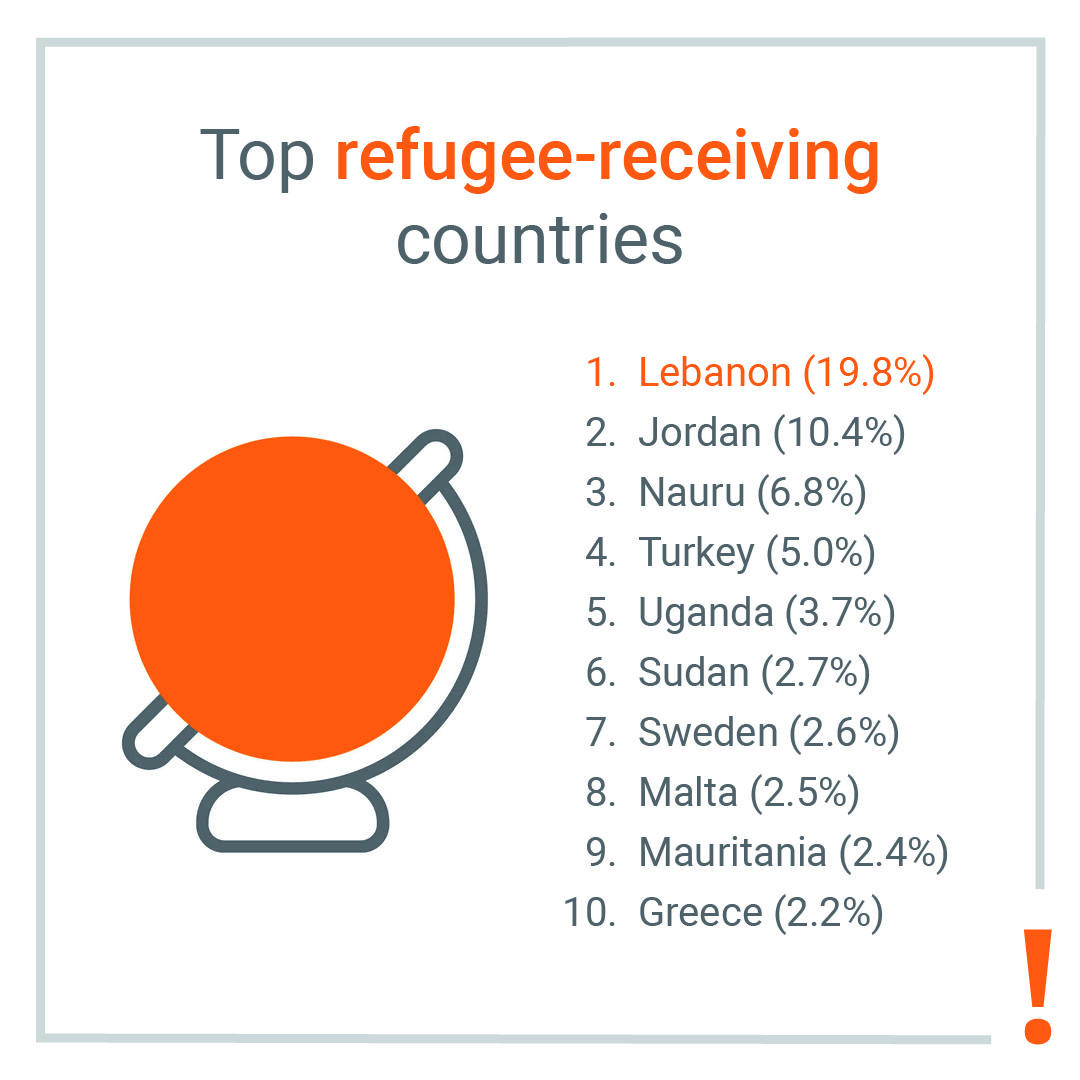Turkey has provided protection to more refugees than any other country in the last ten years. But in terms of refugees as a proportion of the total population, no country comes close to Lebanon. Here are the ten countries that have received the most refugees in relation to their population during the period 2012–2022.
1. Lebanon – 19.8 per cent of the total population
Lebanon, with a population of 6.8 million, is currently hosting an estimated 1.5 million refugees from Syria. The real number is probably even higher because the national authorities demanded that the UN refugee agency (UNHCR) stop the registration of new refugees in 2015. In addition, hundreds of thousands of Palestinian refugees live in the country.
Lebanon itself has been ravaged by a civil war that lasted from 1975 until 1990. It is a densely populated country with a fragile political balance between different ethnic and religious groups.
Since 2019, the situation has gone from bad to worse, with large-scale popular protests eventually leading to the Prime Minister’s resignation. Then, in 2020, Beirut was shaken by a huge explosion, which killed more than 200 people, injured more than 6,000 and left over 300,000 homeless.
Unemployment is sky-high. The country’s currency has collapsed, reaching a historic low in May 2022, meaning much of the population is no longer able to afford the necessities of survival. On top of all this came the Covid-19 pandemic, followed by a rapid rise in food and energy prices as a result of the war in Ukraine.
More than 50 per cent of the population live below the poverty line. For Syrian refugees, the figure is even higher, with 83 per cent living in extreme poverty.
Lebanon now has an urgent need for the rest of the world to step up and help the country that has taken the greatest responsibility for helping displaced people.
2. Jordan – 10.4 per cent
Jordan has received over one million refugees in the last ten years. The vast majority were fleeing neighbouring Syria. While a comparatively small number have since decided to return to Syria or have been able to resettle in other countries, there are still more than 675,000 Syrian refugees registered with the UN refugee agency living in Jordan today.
Over 80 per cent of Syrian refugees in Jordan live in urban centres where they face the challenge of finding sustainable work and affordable housing. Competition for limited employment opportunities can lead to tensions with the local population. The remaining 20 per cent of Syrian refugees live in one of two refugee camps, established by the Jordanian authorities for Syrian refugees and managed by the UN refugee agency.
3. Nauru – 6.8 per cent
This small island state has received boat refugees who were trying to get to Australia when Australian authorities refused to accept them. The UN refugee agency has been highly critical of the agreement Australia has made with Nauru and other countries and is concerned about the reprehensible conditions the refugees live under. Australia has now agreed to stop sending refugees to Nauru.
4. Turkey – 5.0 per cent
Turkey has received more refugees than any other country since 2011 – as many as 4.3 million. Turkey is a large and populous country and is better equipped to handle the challenge than, for example, Lebanon. Nevertheless, it is challenging to provide protection to such a large number of people within a few short years.
Turkey signed an agreement with the European Union (EU) in 2016 that prevents refugees from moving on to Europe. This has had serious consequences for both the refugees who have made it to Greece and those who remain in Turkey.
5. Uganda – 3.7 per cent
Uganda has received 1.8 million refugees over the last ten years and is one of the largest recipients of refugees in the world. In recent years, Uganda has provided protection to people from DR Congo and South Sudan in particular, but the country has also received refugees from Burundi, Somalia, Rwanda and several other countries. Uganda is a pioneer in integrating refugees and giving them full rights.

6. Sudan – 2.7 per cent
With over 1.2 million refugees since 2012, Sudan is the fifth largest recipient country in absolute numbers. Most have fled the conflict in neighbouring South Sudan. In the past year, the country has also received refugees from the conflict in Ethiopia. Sudan is also a key transit country for refugees from Eritrea, Ethiopia and Somalia, among others, who are trying to flee to Europe.
7. Sweden – 2.6 per cent
Sweden has long had the most generous refugee policy in Europe and, unlike many other countries, has actively welcomed refugees. But the large influx of refugees to Europe in 2015, where many European countries were unwilling to share the responsibility, led the government to introduce a temporary law that limited the rights of refugees to a minimum of what the country has committed itself to through international conventions. Despite this, Sweden still received far more refugees than most European countries.
8. Malta – 2.5 per cent
Alongside Sweden, Malta is the Western country that has received the most refugees relative to its population. The country is located near the coast of North Africa and receives many refugees and migrants trying to reach Europe from Libya. The pressure became even greater for a period when Italy made it almost impossible for rescue vessels to dock at its own ports.
9. Mauritania – 2.4 per cent
Mauritania has for decades had an open-door policy towards refugees from the region and is the largest recipient country of refugees from the civil war in neighbouring Mali. It has also for several decades housed refugees from the occupied Western Sahara. In addition, Mauritania has received refugees from a number of other countries, including as far away as Syria.
10. Greece – 2.2 per cent
For a long time, refugees have travelled through Greece on their way to other countries in Europe. But until the so-called European “refugee crisis” in 2015 and 2016, relatively few refugees remained in Greece. This changed dramatically when the EU tightened its refugee policy and demanded that, as a general rule, all refugees should receive protection in the first European country to which they arrived. This put a lot of pressure on Greece, which did not have the capacity to provide good protection to large numbers of refugees. As a result, refugees have had to live in poor conditions in overcrowded camps, including on the Greek islands.






